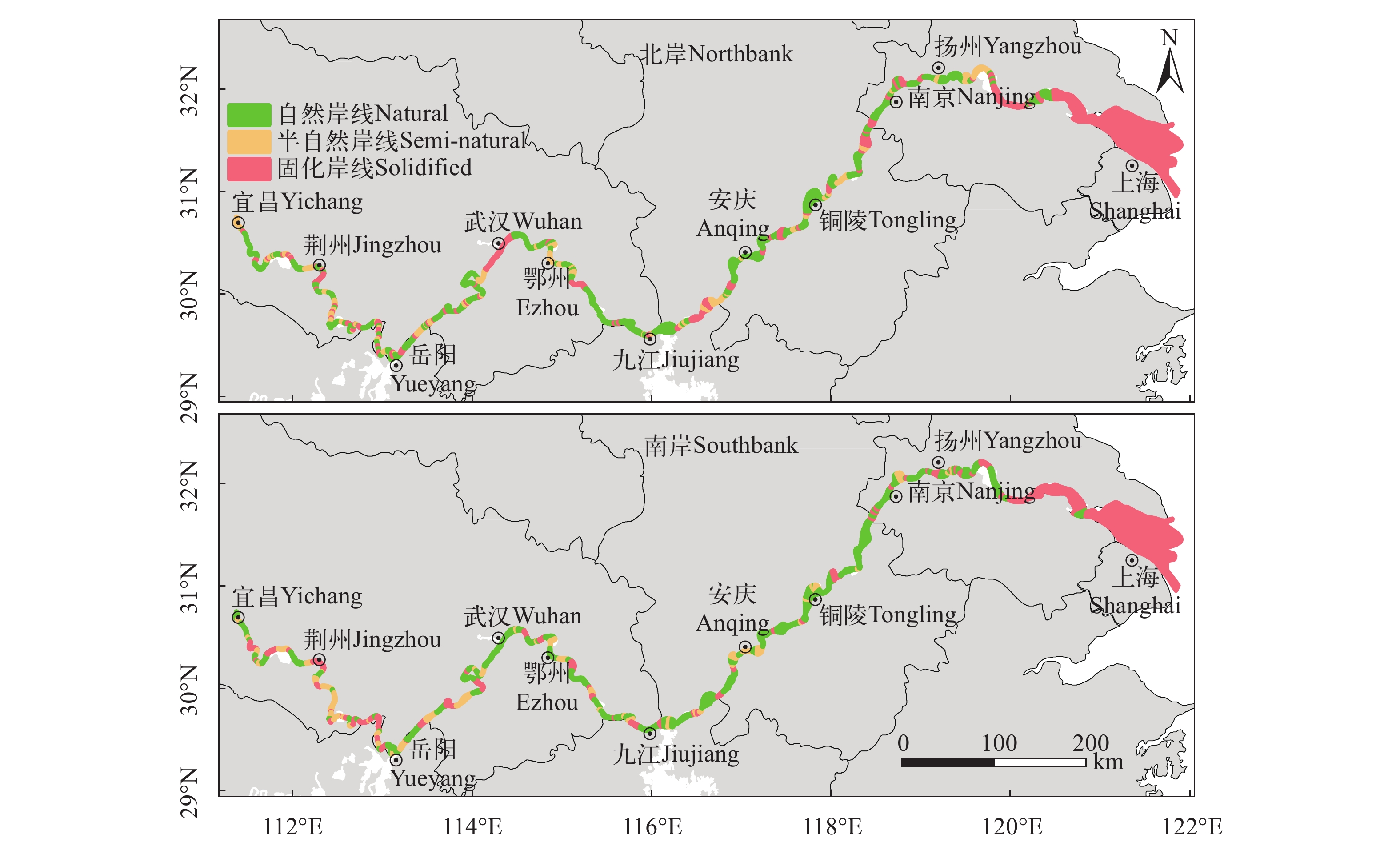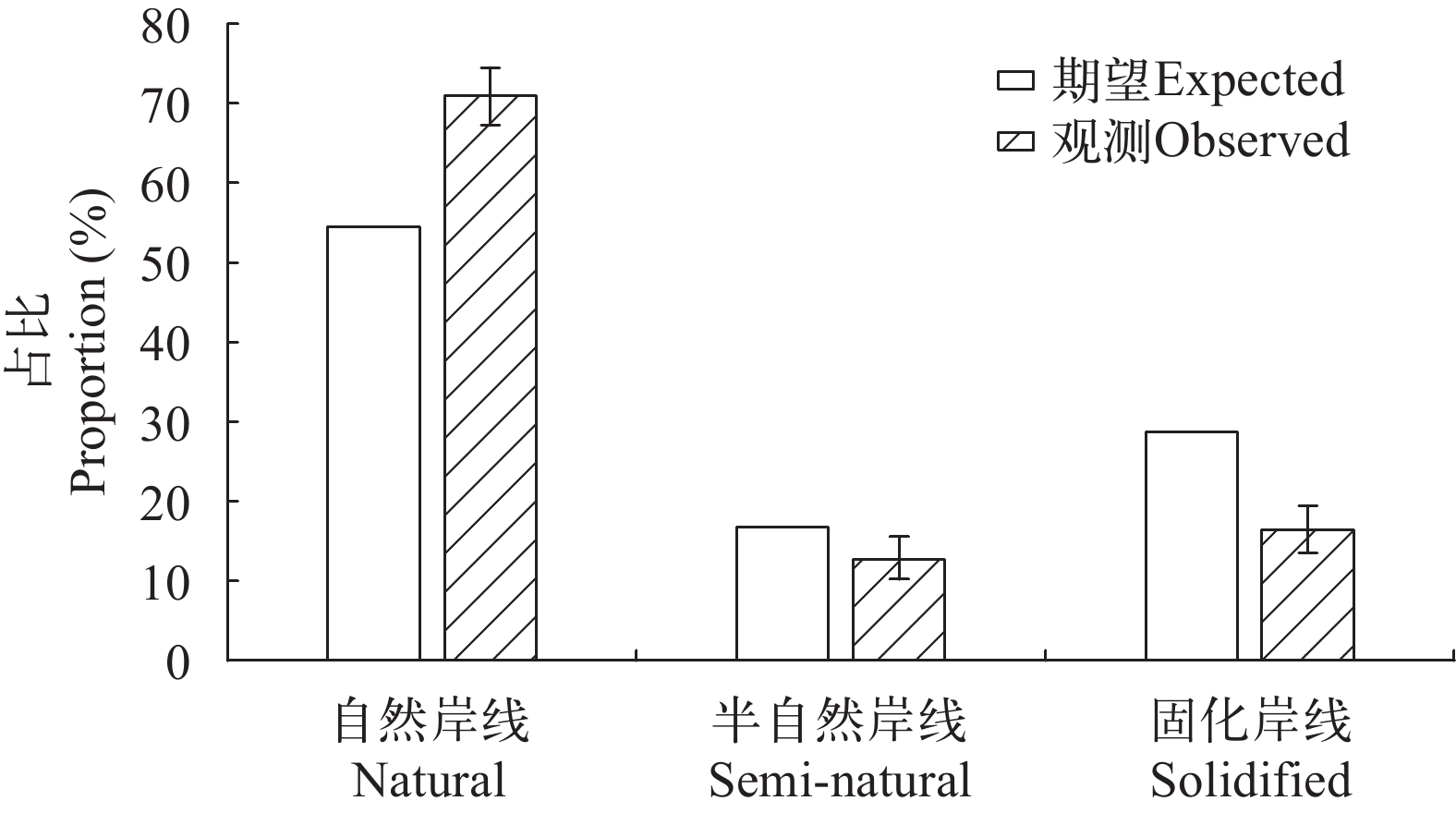RIVER BANK HABITAT ASSESSMENT OF THE YANGTZE FINLESS PORPOISE IN THE MAIN STEM OF MIDDLE-LOWER YANGTZE RIVER
-
摘要: 栖息地环境质量直接影响长江江豚的种群数量与分布, 但当前长江中下游全尺度的江豚栖息地质量状况尚不清楚。研究于2017年11月10日至12月17日“2017年长江江豚生态科学考察”期间, 使用相机拍照采样的方法, 开展了长江中下游干流宜昌至上海江段江豚岸线栖息地质量现状调查。一共采集了794个有效岸线样点, 观察到江豚318次631头次。卡方拟合优度检验结果显示, 江豚在自然岸线的观测频数占比显著性高于其期望频数占比(χ2=68.99, P<0.001), 而在半自然岸线和固化岸线中结果却相反(χ2=39.26, P<0.001; χ2=12.15, P<0.001), 自然岸线是江豚偏好分布的栖息地类型。同时调查表明长江中下游干流自然岸线受到严重破坏, 半自然岸线和固化岸线占比达45.47%。此外, 岸线栖息地破碎化显著, 自然岸线的区域中间都间杂了半固化的或者完全固化的岸线, 这可能是导致长江干流江豚破碎化分布的主要原因。当前长江中下游干流岸线栖息地质量衰退与破碎化现象十分显著, 是江豚生存的重要威胁, 建议实施硬化岸线的自然恢复和重建破碎化岸线的连通性。Abstract: Habitat quality can directly affect population abundance and distribution of the Yangtze finless porpoise. This study investigated habitat status of both south and north banks of the main stem of the Yangtze River by taking high-resolution digital photos systematically during the 2017 Yangtze Freshwater Dolphin Expedition from 10th November to 17th December, 2017. The survey area covered the entire middle and lower reaches of the Yangtze River from Yichang to Shanghai (1669 km in length) and a total of 794 photo samples were collected. We recorded 318 sightings with 631 individuals of the Yangtze finless porpoise. The Chi-squared goodness of fit test revealed that proportions of observed frequency are significantly higher than the expected frequency in natural river banks (χ2=69.81, P<0.001). Whereas the result is opposite in the semi-natural and solidified river banks (χ2=39.26, P<0.001; χ2=12.15, P<0.001), indicating that the natural river banks were the preferred habitat of the Yangtze finless porpoise. The length of the semi-natural river and solidified banks accounted for 45.47% of the total length of the river bank, which intermingled with the patches of the natural river banks, demonstrating that the natural habitat was severely degraded and highly fragmented to impact the distribution of the Yangtze finless porpoise. Our study suggested that habitat degradation and fragmentation pose a significant threat to the survival of the Yangtze finless porpoise. Future conservation research and practice should focus on habitat restoration of the solidified river banks to reestablish and enhance habitat connectivity.
-
Keywords:
- Yangtze finless porpoise /
- Yangtze River /
- Habitat assessment /
- Fragmentation
-
-
表 1 岸线拍摄影像判读指标及标准
Table 1 Indicators and criteria for river bank images
岸线类型Type of river banks 判读标准Criteria 自然泥质或沙质岸线Muddy or sandy river bank 迎水坡面为裸露的洲滩, 自然长草, 底质为泥质或者沙质Riverside slope is covered by plants and the substrate is muddy or sandy 自然岩石质岸线Rocky river bank 迎水坡面为岩石质, 少量有自然长草Riverside slope is covered by rocks and sporadic plants 自然岸线+抛石护坡Natural river bank and riprapping revetment 迎水坡面堤脚用干砌块石、浆砌块石或浆砌预制块进行加固, 上半部分自然长草Lower parts of the riverside slope of the levee are reinforced with riprap and upper parts remains natural 自然岸线+水泥护坡Natural river bank and concrete revetment 迎水坡面堤脚用水泥混凝土硬化加固, 上半部分自然长草Lower parts of the riverside slope of the levee are reinforced with concrete and upper part remains natural 水泥护坡Concrete revetment 迎水坡面全部被水泥混凝土硬化加固Riverside slope is reinforced with concrete 抛石护坡Riprapping revetment 迎水坡面全部被干砌块石、浆砌块石或浆砌预制块进行加固Riverside slope is reinforced with riprap 水泥+抛石护坡Concrete and riprapping revetment 迎水坡面一部分用混凝土加固, 另一部分用干砌块石、浆砌块石或浆砌预制块进行加固Riverside slope is partially reinforced with concrete and partially reinforced with riprap 表 2 长江中下游干流不同区域岸线现状
Table 2 Length of differently types of river banks in the three sections of the middle and lower reachesof the Yangtze River
区域Area 北岸岸线长度Length of the north river bank (km) 南岸岸线长度Length of the south river bank (km) 自然Natural 半自然Semi-natural 固化Solidified 自然Natural 半自然Semi-natural 固化Solidified 宜昌-鄂州Yichang-Ezhou 382 148 168 308 199 191 鄂州-华阳Ezhou-Huayang 142 23 44 138 30 41 华阳-上海Huayang-Shanghai 322 103 315 411 54 275 -
[1] 高安利, 周开亚. 中国水域江豚外形的地理变异和江豚的三亚种. 兽类学报, 1995, (2): 81—92 Gao A L, Zhou K Y. Geographical variation of external measurements and three subspecies of Neophocaena phocaenoides in Chinese waters [J]. Acta Theriologica Sinca, 1995, (2): 81—92
[2] Turvey S T, Pitman R L, Taylor B L, et al. First human-caused extinction of a cetacean species [J]? Biology Letters, 2007, 3(5): 537—540 doi: 10.1098/rsbl.2007.0292
[3] Mei, Z G, Zhang X Q, Huang S L, et al. The Yangtze finless porpoise: On an accelerating path to extinction [J]? Biological Conservation, 2014, (172): 117—123
[4] 张先锋, 刘仁俊, 赵庆中, 等. 长江中下游江豚种群现状评价. 兽类学报, 1993, 13(4): 260—270 Zhang X F, Liu R J, Zhao Q Z, et al. The population of finless porpoise in the middle and lower reaches of Yangtze River [J]. Acta Theriologica Sinca, 1993, 13(4): 260—270
[5] Wang D. Population status, threats and conservation of the Yangtze finless porpoise [J]. Bulletin of the Chinese Academy of Sciences, 2009, 54(1): 3473—3484
[6] 梅志刚. 长江江豚种群变动趋势及濒危机制的研究. 博士学位论文, 中国科学院水生生物研究所, 武汉. 2013 Mei Z G. Study on the Population dynamics and endangered mechanism of the Yangtze finless porpoise [D]. Thesis for Doctor of Science, Institute of Hydrobiology, Chinese Academy of Sciences, Wuhan. 2013
[7] Zhao X, Jay B, Barbaral T, et al. Abundance and conservation status of the Yangtze finless porpoise in the Yangtze River, China [J]. Biological Conservation, 2008, 141(12): 3006—3018 doi: 10.1016/j.biocon.2008.09.005
[8] 戈峰. 现代生态学(第2版). 北京: 科学出版社. 2008: 501 Ge F. Modern Ecology (2nd edition) [M]. Beijing: Science Press. 2008: 501
[9] 魏卓, 王丁, 张先锋, 等. 长江八里江江段江豚种群数量、行为及其活动规律与保护. 长江流域资源与环境, 2002, (5): 427—432 doi: 10.3969/j.issn.1004-8227.2002.05.007 Wei Z, Wang D, Zhang X F, et al. Population size, behavior, movement pattern and protection of Yangtze finless porpoise at Balijiang section of the Yangtze River [J]. Resources and Environment in the Yangtze Basin, 2002, (5): 427—432 doi: 10.3969/j.issn.1004-8227.2002.05.007
[10] 魏卓, 张先锋, 王克雄, 等. 长江江豚对八里江江段的利用及其栖息地现状的初步评价. 动物学报, 2003, 49(2): 163—170 doi: 10.3969/j.issn.1674-5507.2003.02.002 Wei Z, Zhang X F, Wang K X, et al. Habitat use and preliminary evaluation of the habitat status of the Yangtze finless porpoise (Neophocaena phocaenoides asiaeorientalis) in the Balijiang section of the Yangtze River [J]. Acta Zoologica Sinica, 2003, 49(2): 163—170 doi: 10.3969/j.issn.1674-5507.2003.02.002
[11] 赵修江. 河流系统鲸豚类种群数量调查方法探索及其应用研究. 博士学位论文, 中国科学院水生生物研究所, 武汉. 2009 Zhao X J. Investigation of survey methodology on the abundance of cetaceans in Riverine system and its applications [D]. Thesis for Doctor of Science, Institute of Hydrobiology, Chinese Academy of Sciences, Wuhan. 2009
[12] 王丕烈, 中国海兽图鉴. 沈阳: 辽宁科学技术出版社. 1996, 108 Wang P L. Guide to Marine Mammals of China [M]. Shenyang: Liaoning Science and Technology Press. 1996, 108
[13] Mei, Z, Chen M, Li Y, et al. Habitat preference of the Yangtze finless porpoise in a minimally disturbed environment [J]. Ecological Modelling, 2017, (353): 47—53
[14] 于道平, 黄敏毅, 赵凯, 等. 长江东流河道整治对长江江豚种群数量的影响. 兽类学报, 2012, 32(4): 330—334 Yu D P, Huang M Y, Zhao K, et al. Impact of river training on the population abundance of Yangtze finless porpoises in Dongliu section of the Yangtze River [J]. Acta Theriologica Sinca, 2012, 32(4): 330—334
[15] 于道平, 蒋文华, 董明琍, 等. 长江江豚野外健康状况的调查. 动物学杂志, 2002, 37(5): 70—73 doi: 10.3969/j.issn.0250-3263.2002.05.018 Yu D P, Jiang W H, Dong W L, et al. Investigation of health status of Yangtze finless porpoise in the field [J]. Chinese Journal of Zoology, 2002, 37(5): 70—73 doi: 10.3969/j.issn.0250-3263.2002.05.018
[16] Choudhary S, Dey S, Dey S, et al. River dolphin distribution in regulated river systems: implications for dry-season flow regimes in the Gangetic basin [J]. Aquatic Conservation Marine & Freshwater Ecosystems, 2012, 22(1): 11—25
[17] Dudgeon D. Large-scale hydrological changes in tropical Asia: prospects for riverine biodiversity [J]. BioScience, 2000, 50(9): 793—806
[18] Hossain, M M, Alam S M, Baki M A, et al. Ganges river dolphin [J]. Bulletin of the Ecological Society of America, 2016, 97(2): 183—187 doi: 10.1002/bes2.1227
[19] Wu H P, Xu Y H, Peng C W, et al. Long-term habitat loss in a lightly disturbed population of the Indo-Pacific humpback dolphin, Sousa chinensis [J]. Aquatic Conservation: Marine and Freshwater Ecosystems, 2017, 27(6): 1198—1208 doi: 10.1002/aqc.v27.6
[20] Fettermann de Oliveira T. Unmanned aerial vehicle (UAV) remote sensing of behaviour and habitat use of the nationally endangered bottlenose dolphin (Tursiops truncatus) off Great Barrier Island [D]. Thesis for Doctor of Science, Auckland University of Technology, Auckland. 2018: 32—64
[21] Dawson S, Wade P, Slooten E, et al. Design and field methods for sighting surveys of cetaceans in coastal and riverine habitats [J]. Mammal Review, 2008, 38(1): 19—49 doi: 10.1111/j.1365-2907.2008.00119.x
[22] Slooten E, Rayment W, Dawson S. Offshore distribution of Hector’s dolphins at Banks Peninsula, New Zealand: is the Banks Peninsula Marine Mammal sanctuary large enough [J]? New Zealand Journal of Marine and Freshwater Research, 2006, 40(2): 333—343 doi: 10.1080/00288330.2006.9517425
[23] RStudio Team (2016). RStudio: Integrated Development for R. RStudio, Inc., Boston, MA URL http://www.rstudio.com/
[24] Maxime Hervé (2019). RVAideMemoire: Testing and Plotting Procedures for Biostatistics. R package version 0. 9-72. https://CRAN.R-project.org/package=RVAideMemoire
[25] 胡静波. 城市河道生态修复方法初探. 南水北调与水利科技, 2009, 7(2): 128—133 doi: 10.3969/j.issn.1672-1683.2009.02.042 Hu J B. Approach for ecological rehabilitation of urban river course [J]. South-to-North Water Transfers and Water Science & Technology, 2009, 7(2): 128—133 doi: 10.3969/j.issn.1672-1683.2009.02.042
[26] Kimura S, Akamatsu T, Li S H, et al. Seasonal changes in the local distribution of Yangtze finless porpoises related to fish presence [J]. Marine Mammal Science, 2012, 28(2): 308—324 doi: 10.1111/mms.2012.28.issue-2
[27] Wang Z, Akamatsu T, Wang K, et al. The diel rhythms of biosonar behavior in the Yangtze finless porpoise (Neophocaena asiaeorientalis asiaeorientalis) in the port of the Yangtze River: the correlation between prey availability and boat traffic [J]. PLoS One, 2014, 9(5): 1—12
[28] Wang Z, Akamatsu T, Mei Z, et al. Frequent and prolonged nocturnal occupation of port areas by Yangtze finless porpoises (Neophocaena asiaeorientalis): Forced choice for feeding [J]. Integrative Zoology, 2015, 10(1): 122—132
[29] 陈敏敏, 刘志刚, 黄杰, 等. 固化河岸对长江江豚栖息活动的影响. 生态学报, 2018, 38(3): 945—952 Chen M M, Liu Z G, Huang J, et al. Effects of artificial shorelines on distribution of the Yangtze finless porpoise in the Anqing section of the Yangtze River main stem [J]. Acta Ecological Sinica, 2018, 38(3): 945—952
[30] 居涛, 张天赐, 王志陶, 等. 抛石噪声特性及其对长江江豚的可能影响. 声学技术, 2017, 36(6): 580—588 Ju T, Zhang T C, Wang Z T, et al. Characteristics of riprapping underwater noise and its possible impacts on the Yangtze finless porpoise [J]. Technical Acoustics, 2017, 36(6): 580—588
[31] Dong L J, Wang D, Wang K X, et al. Yangtze finless porpoises along the main channel of Poyang Lake, China: Implications for conservation [J]. Marine Mammal Science, 2015, 31(2): 612—628 doi: 10.1111/mms.2015.31.issue-2




 下载:
下载:

